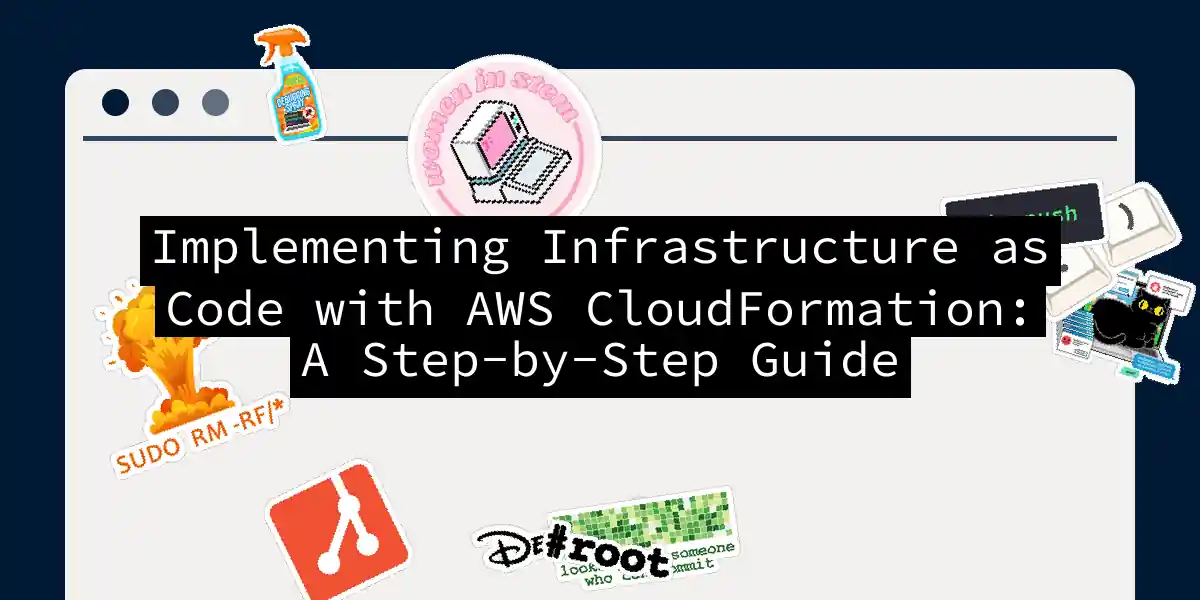Introduction to Infrastructure as Code
In the ever-evolving landscape of software development, managing infrastructure has become a critical aspect of ensuring scalability, reliability, and efficiency. This is where Infrastructure as Code (IaC) comes into play, allowing you to treat your infrastructure configuration as you would any other code. One of the most powerful tools for implementing IaC on AWS is CloudFormation. In this article, we’ll delve into the world of CloudFormation, exploring its benefits, how it works, and a step-by-step guide to getting you started.
What is AWS CloudFormation?
AWS CloudFormation is a service offered by AWS that allows you to create and manage your AWS resources using templates. These templates are written in JSON or YAML and describe the AWS resources you want to create and configure. CloudFormation is a declarative service, meaning you define what you want to create, and it takes care of the details of how to create it.
Benefits of Using CloudFormation
- Simplified Management: With CloudFormation, you can manage your infrastructure consistently and reproducibly. You can store your configuration files in a version control system, track changes, and validate them during code reviews.
- Increased Productivity: CloudFormation’s declarative approach saves you time by automating the ordering and creation of resources. This enhances productivity and avoids tedious manual tasks.
- Efficient Code Management: CloudFormation allows you to structure your infrastructure code using stacks, which facilitates code management, resource reuse, and adoption of software development best practices.
Setting Up Your Environment
Before diving into CloudFormation, you need to set up your environment.
Step 1: Install and Configure the AWS CLI
To work with CloudFormation, you’ll need the AWS CLI installed and configured on your machine. Here’s how you can do it:
# Install AWS CLI
curl "https://awscli.amazonaws.com/awscli-exe-linux-x86_64.zip" -o "awscli-exe-linux-x86_64.zip"
unzip awscli-exe-linux-x86_64.zip
sudo ./aws/install
# Configure AWS CLI
aws configure
Step 2: Create a CloudFormation Template
A CloudFormation template is the heart of your infrastructure definition. Here’s a simple example of a template that creates a VPC, a subnet, an internet gateway, and an EC2 instance:
AWSTemplateFormatVersion: '2010-09-09'
Resources:
VPC:
Type: AWS::EC2::VPC
Properties:
CidrBlock: 10.0.0.0/16
Subnet:
Type: AWS::EC2::Subnet
Properties:
VpcId: !Ref VPC
CidrBlock: 10.0.1.0/24
AvailabilityZone: us-east-1a
InternetGateway:
Type: AWS::EC2::InternetGateway
AttachGateway:
Type: AWS::EC2::VPCGatewayAttachment
Properties:
VpcId: !Ref VPC
InternetGatewayId: !Ref InternetGateway
RouteTable:
Type: AWS::EC2::RouteTable
Properties:
VpcId: !Ref VPC
Route:
Type: AWS::EC2::Route
Properties:
RouteTableId: !Ref RouteTable
DestinationCidrBlock: 0.0.0.0/0
GatewayId: !Ref InternetGateway
RouteTableAssociation:
Type: AWS::EC2::SubnetRouteTableAssociation
Properties:
SubnetId: !Ref Subnet
RouteTableId: !Ref RouteTable
SecurityGroup:
Type: AWS::EC2::SecurityGroup
Properties:
GroupDescription: Allow SSH from anywhere
VpcId: !Ref VPC
SecurityGroupIngress:
- IpProtocol: tcp
FromPort: 22
ToPort: 22
CidrIp: 0.0.0.0/0
EC2Instance:
Type: AWS::EC2::Instance
Properties:
InstanceType: t2.micro
ImageId: ami-0c94855ba95c71c99 # Replace with your desired AMI
SubnetId: !Ref Subnet
SecurityGroupIds:
- !Ref SecurityGroup
KeyName: your-ssh-key # Replace with your SSH key name
Step 3: Create a CloudFormation Stack
To create a CloudFormation stack, you can use the AWS CLI or the AWS Management Console. Here’s how you can do it using the AWS CLI:
aws cloudformation create-stack --stack-name my-first-stack --template-body file://path/to/your/template.yaml --capabilities CAPABILITY_IAM
Understanding CloudFormation Templates
CloudFormation templates are the backbone of your infrastructure configuration. Here are some key components of a CloudFormation template:
Resources
Resources are the AWS components you want to create. In the example above, we defined resources such as a VPC, subnet, internet gateway, route table, security group, and an EC2 instance.
Parameters
Parameters allow you to input values when you create or update a stack. This makes your templates more flexible and reusable.
Parameters:
VpcCidrBlock:
Type: String
Default: 10.0.0.0/16
Description: The CIDR block for the VPC
Resources:
VPC:
Type: AWS::EC2::VPC
Properties:
CidrBlock: !Ref VpcCidrBlock
Mappings
Mappings allow you to define key-value pairs that you can use to configure your resources.
Mappings:
RegionMap:
us-east-1:
AMI: ami-0c94855ba95c71c99
us-west-1:
AMI: ami-0d70546e43a941d70
Resources:
EC2Instance:
Type: AWS::EC2::Instance
Properties:
ImageId: !FindInMap [RegionMap, !Ref 'AWS::Region', AMI]
Conditions
Conditions allow you to control the creation of resources based on logical conditions.
Conditions:
CreateProdResources: !Equals [Ref EnvironmentType, prod]
Resources:
EC2Instance:
Type: AWS::EC2::Instance
Condition: CreateProdResources
Properties:
InstanceType: t2.micro
ImageId: ami-0c94855ba95c71c99
Managing Changes and Updates
One of the powerful features of CloudFormation is its ability to manage changes and updates to your infrastructure.
Change Sets
When you need to update your stack, CloudFormation creates a change set that outlines the changes to be made. You can review and approve this change set before applying it.
aws cloudformation create-change-set --stack-name my-first-stack --template-body file://path/to/your/updated-template.yaml --change-set-name my-change-set
aws cloudformation describe-change-set --stack-name my-first-stack --change-set-name my-change-set
aws cloudformation execute-change-set --stack-name my-first-stack --change-set-name my-change-set
Rollback Mechanism
If something goes wrong during the update process, CloudFormation’s rollback mechanism ensures that your infrastructure is restored to its previous state.
Best Practices and Tips
Use Nested Stacks
Nested stacks allow you to reuse templates within other templates, making your infrastructure code more modular and maintainable.
Resources:
VPCStack:
Type: AWS::CloudFormation::Stack
Properties:
TemplateURL: https://s3.amazonaws.com/my-bucket/vpc-template.yaml
Validate and Test Your Templates
Always validate your templates before deploying them to production. CloudFormation provides a validation engine that scans your template for syntax and semantic errors.
aws cloudformation validate-template --template-body file://path/to/your/template.yaml
Use Version Control
Store your CloudFormation templates in a version control system like Git. This allows you to track changes and collaborate with your team more effectively.
Conclusion
Implementing Infrastructure as Code with AWS CloudFormation is a powerful way to manage and deploy your cloud resources. By using CloudFormation, you can ensure consistency, reproducibility, and scalability in your infrastructure. Remember to follow best practices such as using nested stacks, validating your templates, and storing them in version control.
As you embark on this journey, keep in mind that IaC is not just about writing templates; it’s about creating a culture of automation and continuous improvement within your team. So, go ahead, dive into the world of CloudFormation, and watch your infrastructure management become a breeze.
